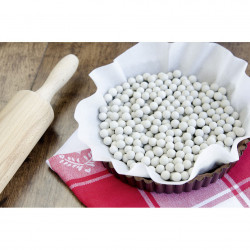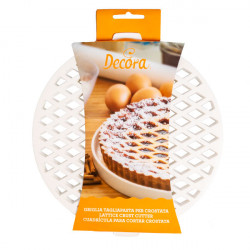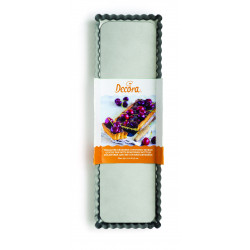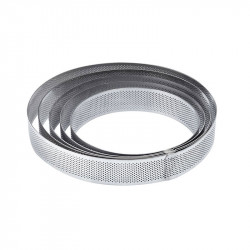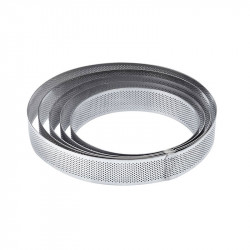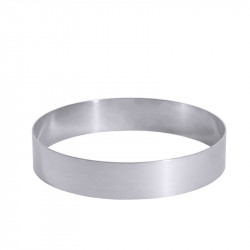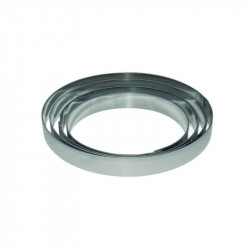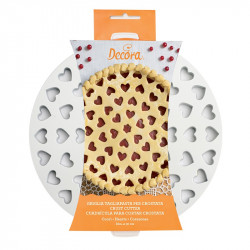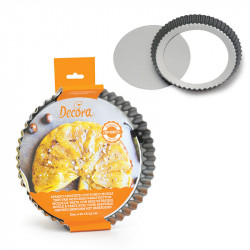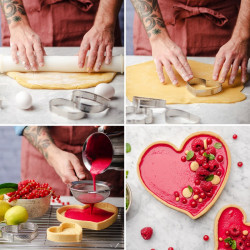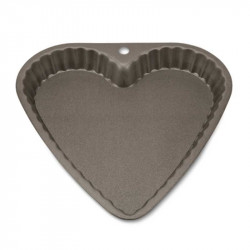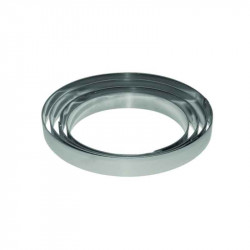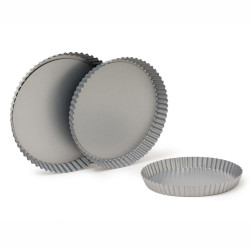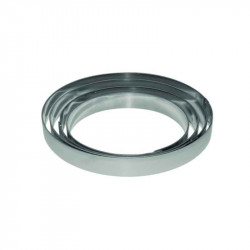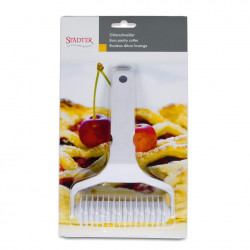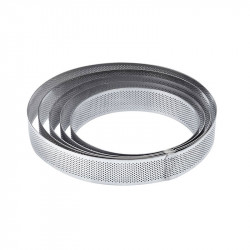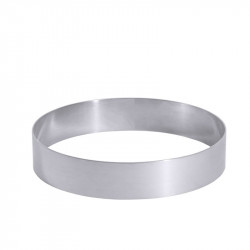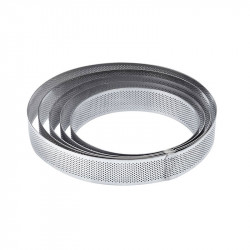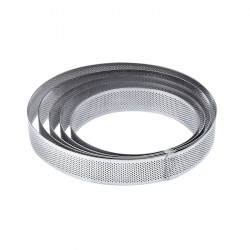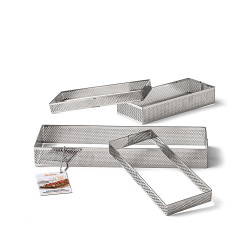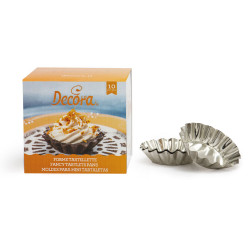Quiche & Tart Molds
What is the difference between a quiche and a tart?
The main difference between a quiche and a tart is the type of filling and the preparation of the dough.
- Quiche: The quiche is a hearty French specialty. It is filled with a mixture of eggs, cream and mixed vegetables, meat, fish or cheese. The filling is placed in a savory shortcrust pastry and baked in the oven.
- Tarte: The tarte is a French dessert. It is filled with a sweet filling such as fruit, custard or chocolate. The filling is often spread on a sweet shortbread base and also baked in the oven.
In summary, quiche and tarte differ in the type of filling: Quiche is savory and tarte is sweet. Also, quiche often uses a savory shortcrust pastry, while tarte uses a sweet shortcrust pastry.
How to make a quiche?
To make a quiche you need the following ingredients:
- 250g flour
- 125g cold butter
- 1 pinch of salt
- 3-4 tbsp water
- 200g bacon cubes or vegetables such as spinach, mushrooms or onions
- 200g grated cheese (eg. Gouda or Emmental)
- 4 eggs
- 250ml cream
- salt, pepper, nutmeg to taste
And this is how it's done:
1. Put the flour, cold butter in small pieces and a pinch of salt together in a bowl. Knead with your hands or a kitchen mixer until you have a crumbly dough.
2. Gradually add the water and continue kneading until you have a smooth dough. Form the dough into a ball, wrap in plastic wrap and refrigerate for at least 30 minutes.
3. Preheat the oven to 180 degrees Celsius.
4. Remove the dough from the refrigerator and roll it out on a floured work surface until it is large enough to line a baking pan with.
5. Place the dough in the baking pan and press down on the sides. Prick the bottom several times with a fork to avoid bubbles. Then cover the dough with baking paper and weigh it down with dried pulses.
6. Blind bake the dough base in the preheated oven for about 10 minutes. Then remove the baking paper with the legumes and bake the pastry base again for another 5 minutes.
7. Meanwhile, fry the bacon or vegetables in a pan until lightly browned. Remove the pan from the heat and let the bacon or vegetables cool.
8. In a bowl, crack the eggs and mix with the cream. Season with salt, pepper and nutmeg.
9. Spread the bacon or vegetables and the grated cheese on the pre-baked pastry base.
10. Pour the egg and cream mixture over the topping.
11. Place the quiche in the preheated oven for approx. 25-
How to make a tart?
To make a tart you need the following ingredients:
- 250g flour
- 125g cold butter
- 1 pinch of salt
- 1 egg
- 2-3 tablespoons cold water
For the filling:
- as you like fruit, vegetables, cheese, etc.
- eggs (optional)
- cream (optional)
- spices and herbs (optional)
1. First mix the flour with the pinch of salt. Cut the cold butter into small pieces and add to the flour. Using your hands or a mixer, work the butter into the flour until the mixture has a sandy consistency.
2. Add the egg and cold water and knead everything into a dough. If the dough is too dry, add a little more water. Shape the dough into a ball, wrap it in plastic wrap and let it rest in the refrigerator for about 30 minutes.
3. Preheat the oven to 180°C. Remove the dough from the refrigerator and roll out thinly on a floured work surface. Line a tart pan with the dough, forming a rim.
4. Place the desired filling on the dough. For example, for sweet tartes, this can be pieces of fruit; for savory tartes, it can be vegetables and cheese. Optionally, you can pour beaten eggs and cream over the filling to bind it together.
5. Bake the tart in the preheated oven for about 30-40 minutes, until the filling is set and the dough is golden brown.
6. Remove the tart from the oven and let it cool a bit before serving.
Tartes can be prepared with different fillings, depending on taste and season. The possible combinations are many, so feel free to experiment with different ingredients and spices.
What kind of mistakes can happen when making a quiche or a tart?
Several mistakes can occur when making a quiche or tart:
1. Broken dough: The dough for the quiche or tart can easily break when rolled out or transferred to the baking pan, resulting in holes or cracks in the dough.
2.. dough too thick: If the dough is rolled out too thick, it may become too firm or dry when baked.
3. dough too thin: If the dough is rolled out too thin, it may become soggy when baked and allow the filling to seep through.
4. filling overflow: If too much filling is added to the tart or quiche, it can overflow the edges during baking and cause the bottom to soak.
5. Filling too watery: If the filling contains too much liquid, it can soak the dough and create a soft, mushy texture.
6. Filling not seasoned enough: If the filling is not seasoned enough, the final product can be bland and tasteless.
7. Overbaking or underbaking: If the quiche or tart is baked too long or too short, it may be either too dry, too firm, or too soft.
8. Insufficient cooling time: After baking, it is important that the quiche or tart cool sufficiently before cutting. Otherwise, it may fall apart or the filling may still be liquid.
What qualities should a tart baking pan or quiche baking pan have?
A good tart or quiche baking pan should have several qualities:
1. Shape and size: The baking pan should be the right size to provide enough space for the dough and filling and to allow even baking. Also, the pan should have a flat and stable bottom surface to allow easy removal of the tart or quiche.
2. Non-stick coating: A non-stick coating makes it easier to remove the tart or quiche from the pan and ensures that it does not stick to the surface. This also makes it easier to clean the mold.
3. Material: Baking molds for tart or quiche are available in different materials, such as metal, glass or ceramic. It is important that the material has good heat conduction to ensure even heat distribution during baking. Metal pans are usually best, as they offer fast and even heat conduction.
4. Rim: The rim of the baking pan should be high enough to hold the filling and ideally easily removable to make it easier to remove the tart or quiche.
5. Heat resistance: The pan should be heat resistant to withstand high baking temperatures without bending or damaging.
6.Ease of care: A good tart or quiche pan should be easy to clean, hand or dishwasher safe, and retain its quality after frequent use.
In summary, a tart or quiche pan should be the right shape and size, have a non-stick coating, be made of a material with good heat conduction, have a high rim, be heat resistant, and be easy to clean.
Where to buy a tart or quiche baking dish?
Tart molds or quiche molds can be found in special baking stores or online stores. In Switzerland, there is a large bakery store in Zurich Adliswil called miniSchoggi, which has a large selection of different baking molds for quiches and tarts. In the bakery store you can buy your suitable baking mold directly on the spot. In addition, miniSchoggi also has a large online store where you can buy the baking molds online and have them delivered to your home.
How to properly clean a tart or quiche baking dish?
To properly clean a tart or quiche pan, follow these steps:
1. After removing the tart or quiche from the pan, allow the pan to cool before cleaning.
2. First, remove any food residue or crumbs from the surface of the pan. It is best to use a soft brush or sponge.
3. Fill the mold with warm water and add a mild dishwashing liquid. Allow the mold to soak for a few minutes to loosen grease and grime.
4. Then use a soft brush or sponge to thoroughly clean the mold. Be sure to reach all corners, grooves and recesses.
5. Rinse the mold thoroughly with warm water to remove all soap residue.
6. Then dry the mold thoroughly to prevent rusting. You can wrap it in a towel or let it air dry.
7. For stubborn stains or discoloration, you can use baking soda or lemon juice. Sprinkle some baking soda on the mold and rub it in with a sponge or brush. Let it work for a few minutes and then rinse the mold thoroughly.
8. If necessary, you can also clean the mold in the dishwasher, provided it is dishwasher safe. However, read the manufacturer's instructions to make sure the mold is dishwasher safe.
Always make sure to dry the mold properly after cleaning to avoid mold growth or rust.
What are the advantages and disadvantages of a tart pan with a lifting bottom?
Advantages:
1. Easy removal of the tart from the mold: The lift bottom makes it easy to lift the tart out of the pan without breaking or damaging it.
2. Even heat distribution: The lift bottom allows for even heat distribution, resulting in even browning of the tart.
3. Easy cleaning: Because the raised bottom is usually removable, the pan is easy to clean.
4. Versatility: A tart pan with a raised bottom can be used to prepare not only tartes, but also quiches and other baked goods.
Disadvantages:
1. Cost: Tart pans with raised bottoms are usually more expensive than conventional pans.
2.. size: Depending on the size, the mold may be bulky and require more storage space in the kitchen.
3. Takes some getting used to: The lift bottom requires some practice to make sure it works properly and the tart does not fall off.
4. Limited usability: The lift bottom may not be suitable for all types of tartes or baked goods.
Do you need a non-stick coating on a tart pan or quiche pan?
It is not essential to have a non-stick coating on a tart baking pan or quiche pan, but it can make baking and removing the tart or quiche easier. A non-stick coating prevents the dough from sticking to the pan and makes it easier to remove the tart or quiche after baking. It is helpful to grease the pan before first use and let the dough roll out well to prevent sticking if there is no non-stick coating.
What is the difference from a tarte to tartelettes?
A tarte is a French savory or sweet dish consisting of a shortbread base topped with a filling of fruit, vegetables, meat, cheese or a cream. It is prepared in a round tarte pan.
Tartelettes are small versions of the tarte. They have a similar structure, but consist of small individual portions, usually prepared in special tartelet molds. The dough base and filling are often thicker than in a tarte because they don't cook through as quickly in the smaller ramekins.
So basically, the difference is in the size and shape of the dish. Tartelettes are smaller and more individual, while tartes are prepared in a larger mold.
How to remove a tart from the mold again?
To remove a tart from the pan, follow these steps:
1. Allow the tart to cool completely. This is important to ensure that the texture of the tart is firm enough to remove from the pan without breaking it.
2. Carefully remove the edge of the tart pan. Most tart pans have a removable rim. Loosen the clasps on the rim and slowly lift it off the tart.
3. Carefully slide a tart lifter or large kitchen knife under the tart to loosen it from the bottom of the pan. Slowly lift the tart until it is completely released from the pan.
4. Transfer the tart to a serving platter or directly to a plate. Follow the instructions of the recipe or your personal preferences.
5. Enjoy! Now you can enjoy the tart.
It is important to be careful when removing the tart from the pan so as not to damage it. However, a well-baked tart should be relatively easy to remove from the pan, especially if you remove the edge of the tart pan.
What is a fruitcake mold?
A fruit cake pan is a special baking pan used specifically for baking fruit cakes. It usually has a round or square shape and a removable bottom to easily release the cake from the mold. The mold is usually made of metal and often has a non-stick coating to prevent the cake from sticking. The special shape makes a fruit cake pan particularly suitable for arranging fruit on the cake and allows the batter to bake evenly.
How to make a tarte tatin?
To make a Tarte Tatin, follow these steps:
1. First you need to prepare the dough. In a bowl, mix 250 g of flour, 125 g of cold butter in small pieces, 1 egg, 1 pinch of salt and 1 tsp of sugar. Knead the ingredients until you get a smooth dough. Wrap the dough in plastic wrap and let it rest in the refrigerator for at least 30 minutes.
2. Meanwhile, peel 6 to 8 apples and cut them into quarters. Remove the cores and make sure the apples are cut evenly.
3. Now you need to make the caramel. Put 100 g of sugar in a pan and heat it over medium heat. Make sure not to stir the sugar, just let it melt. Once the sugar has melted and turned a golden brown color, remove the pan from the heat.
4. Add 50 g of cold butter to the pan with the melted sugar and stir well until the butter is melted and mixed with the caramel.
5. Place the apple quarters in the pan with the caramel, rounded side down. Arrange the apples in a circular shape until the bottom of the pan is completely covered.
6. Roll out the pastry and place it over the apples so that the apples are completely covered.
7. Bake the tart in a preheated oven at 180 degrees Celsius for about 25 to 30 minutes or until the pastry is golden brown.
8. When the tart comes out of the oven, let it cool for a few minutes. Then take a plate or platter, place it over the pan and carefully turn the tarte over so that the apples are on the plate and the dough is on top.
9. Serve the Tarte Tatin warm, possibly with a scoop of vanilla ice cream or whipped cream.
And voilà, your Tarte Tatin is ready! Bon appetit!
How big should a quiche or a tarteforme be?
The size of the quiche or tart pan depends on the desired portion size and the desired thickness of the dough. As a rule, quiche or tart molds have a diameter of about 20-30 centimeters and are about 3-5 centimeters deep. It is also possible to use smaller or larger molds, depending on individual preferences and requirements.

